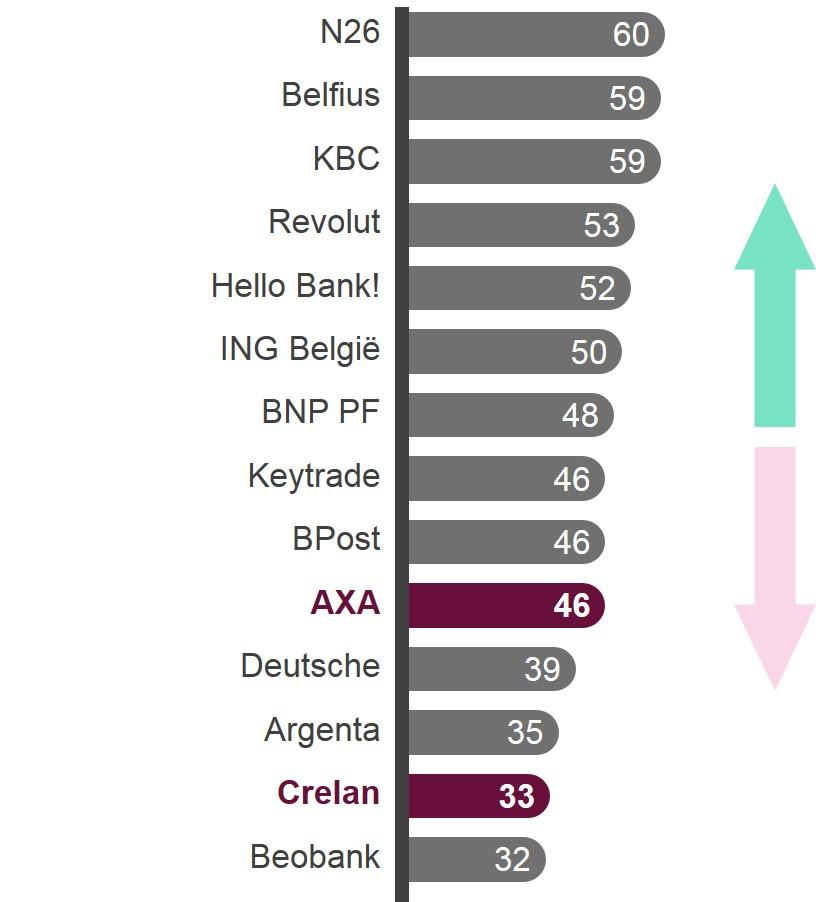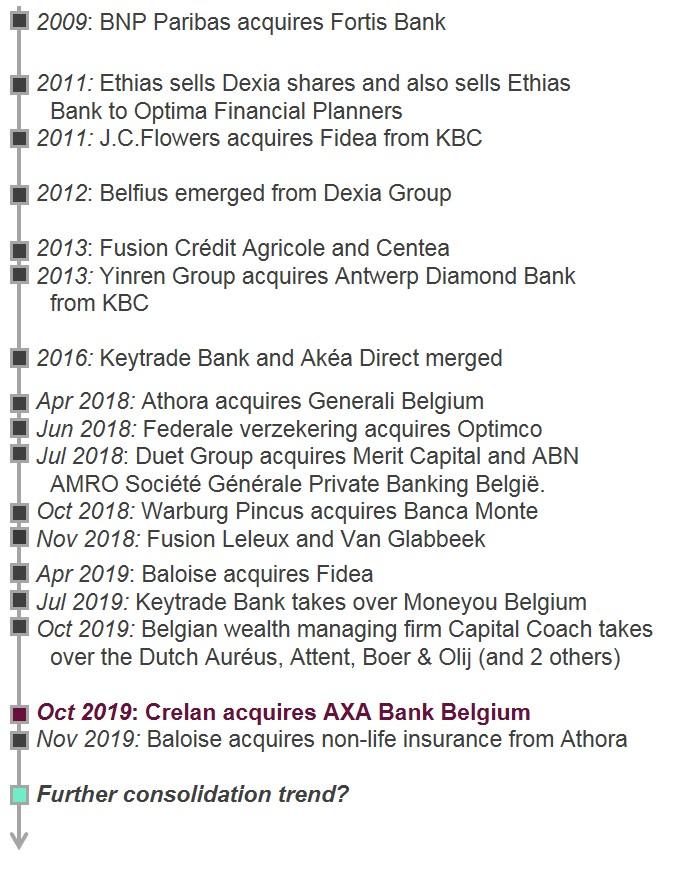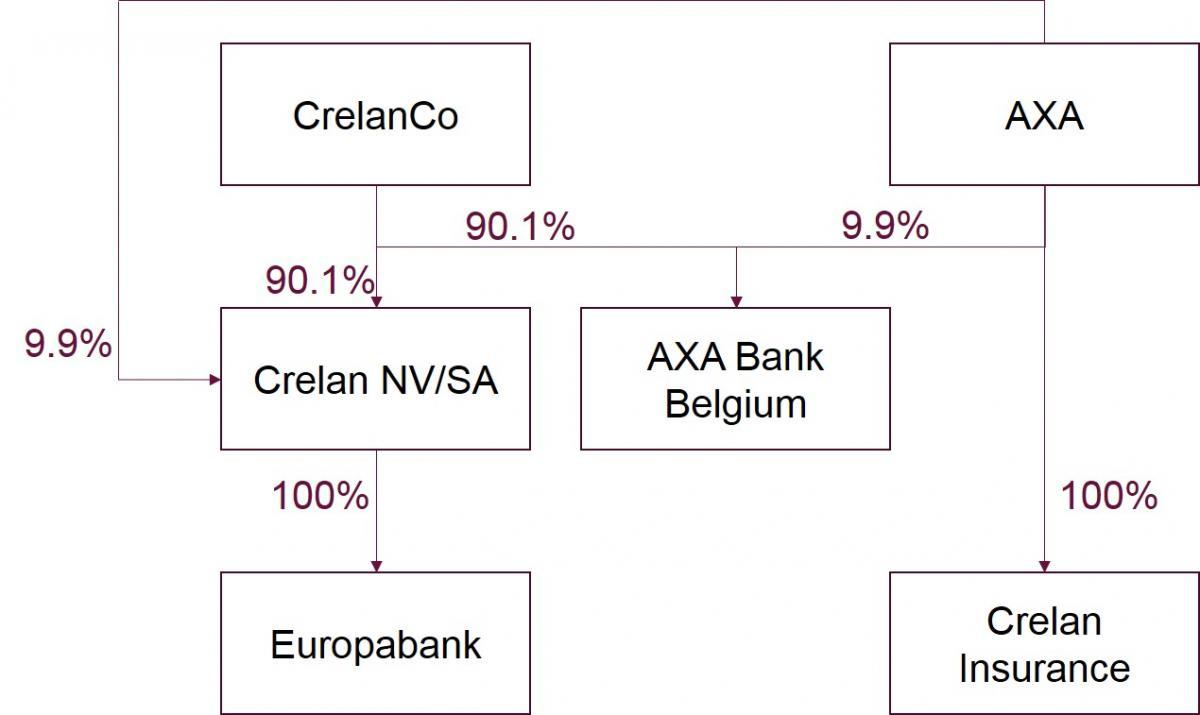Resetting the Flight Path: Strategic…

What to learn from Axa and Crelan?

The announcement in October 2019 that AXA sold its Belgian bank division to Crelan can hardly be considered as a surprise. Both banks were behind the competition based on client coverage, AUM, loans... whereas now due to the acquisition, Crelan will double in size and become the fifth biggest player in terms of AUM and clients in the Belgian banking market (€37 billion deposits, €38 billion in loans and 1.7 million clients). Crelan aspires to compete with the Belgian market leaders (Belfius, KBC, ING Belgium, BNP Paribas Fortis) and hopefully strengthen its profitability through cost-sharing and network effects. Complementary to this deal, Crelan will transfer its Belgian insurance division to AXA Group, albeit rather marginal in size.
More consolidations in the Belgian banking market (and worldwide) will occur in the future due to heavy investments in digitalization and low margins that banks are facing. The creation of a larger entity leads to a more efficient, robust institution with economies of scale, synergies and better diversified risks. Smaller banks have two strategic possibilities in the consolidation wave: to expand or sell.
The digitalization wave is associated with substantial investments that every bank has to undergo. Banks have to spend big amounts of resources in updating internal (IT) processes next to the investments in digital applications. Examples are the implementation of state-of-the-art technologies (Robot Process Automation, Blockchain, Artificial Intelligence, Biometrics etc.) to streamline the working and efficiency of internal processes. Those technologies are required by financial institutions to deal with stringent regulations set up by banking authorities. Biometrics and Blockchain, for example, can be implemented in the Know Your Customer process to handle anti-money laundering regulations. Finally, in order to stay competitive in the following years, exploiting PSD2 and Open Banking opportunities is key but will require consequent IT investments too. The larger scale and broader client portfolio post-acquisition should help the bank to bear these significant investment costs. As can be seen in Figure 1, both Crelan and Axa Bank are lagging behind the market leaders in terms of digital capabilities and substantial investments are required. Their mobile applications lack basic features that the competition implemented a long time ago (fingerprint signature, transferring money through QR codes, NFC, ...). By combining strengths, a well-performing app can be created with a sufficient number of features that is nowadays expected by the Belgian customers. After the merger, Crelan will double in size (roughly doubling the net income) resulting in a lower percentage of turnover spent on all aforementioned implications.

Figure 1 - Digital proposition score of Belgian banks (Sia Partners & D-rating)[1]
The European Central Bank performed a study in 2014 regarding the impact of banks’ mergers on performance and this indicated that there is an increase in post-merger performance following cross-border mergers of 2.5% on their return on capital (a median return of 1.5%) [2]. Domestic mergers, however, experience an average increase in ROE of 1.2% and other studies indicate that banks engaging in M&A experience a decrease in their performance (ROE) post-merger but show a pronounced improvement in cost efficiency in the years after the deal [3]. With that in mind, Crelan aims to increase their returns through the acquisition of Axa Bank.
[1] Sia Partners source, D-rating source, 2020 Benchmark in Tendances
[2] ECB source
[3] LSE source
Two factors have especially been hurting banks’ bottom lines for many years now, both on the income and on the cost side. On the one hand, low interest rates impact revenue, and on the other hand changing customer expectations, mainly driven by a need for digitalization of the channels, are putting additional pressure on costs.
On the income side, close-to-zero interest rates and increasing competition put pressure on banks’ traditional business model and profitability. Therefore, post-merger economies of scale should lead to higher profit margins for the combined group through extended customer reach and lower cost base.
On the cost side, banks firstly need to restructure their traditional retail channels towards more mobile & internet banking. A shift towards mobile banking requires, as mentioned before, heavy investments in digital resources. Figures from Febelfin indicate that Belgian e-banking and mobile banking are strongly on the rise: almost 13 million subscriptions for internet banking and 7 million subscriptions for mobile banking [4].
Secondly, after the acquisition, Crelan will have 1141 branches which is the highest branch per customer ratio comparing to 600-700 branches of the four Belgian leaders (Belfius, KBC, ING Belgium, BNP Paribas Fortis). All plan to close additional branches in the coming years because of their expensive (staff) operating costs and the digital transformation that financial institutions face.

BNPPF announced that they will reduce their number of branches in the coming years (see Table 1). A more detailed geographical analysis of branches from Crelan and AXA Bank indicates that almost 30% of the branches are located in less than 500 meters from each other. To increase cost effectiveness, Crelan should target to have the same branch/client ratio as BNPPF, operating 210 branches at the end of 2021 (a drastic decrease of -82% from the current number of branches). Crelan will have to follow the trend of closing branches over the following years. Downsizing the branches network will result in significant cost savings for the combined group and is necessary to compete with the leading Belgian banks.
More information can be found in the Sia Partners media acclaimed article ‘The acceleration of branch closures in France’ [5].
Another study on European bank mergers and its impact on branches confirms these trends and highlights that over the period 2010-2017, the number of branches per thousand inhabitants decreased from 0.44 to 0.35, while the number of employees per thousand inhabitants decreased from 7.8 towards 6.7 in 2017 [6]. This again shows that the shift towards digital and mobile banking tends to be accompanied by a cost-reduction exercise.

[4] European Banking Federation and Febelfin source
[5] Sia Partners France study, Option Finance
[6] VOX source
Banks need to team up (and achieve scale) to prepare against big (foreign) banks, Neobanks and GAFA (Google announced in the middle of November 2019 that it will offer bank services for US customers in the course of next year) [7]. All those (new) dynamic entrants would like to get a foot in the door of the Belgian market. Through scale, the banks can defend their position when aggressive new players will make their push into the financial services industry, knowing that new big technology entrants definitely have deep pockets to fight the battle.
[7] Google, Amazon, Facebook and Apple
The driving factors of the overall degree of overcapacity in banking are non-bank competition [8], the interest rate environment and bank’s business models according to a recent report of the ECB [9]. Overbanking is often indicated as one of the reasons for the low (subdued) profitability, the Return on Equity is still below the Cost of Equity for many banks [10].
Most countries have managed to reduce overcapacities in banking since the financial crisis by deleveraging, rationalizing costly physical infrastructure and exploiting the benefits of technological innovation. But still, the European banking sector is too large and results in a need for consolidation. It’s all about more efficient banks, market forces determining the structure of the sector, and having both cross-border and domestic mergers. The latter makes sense from a cost-efficiency viewpoint as this is what Crelan aims to achieve.
[8] Non-bank competition: Share of non-bank credit in total credit to the non-financial private sector
[9] ECB Overcapacity source
[10] ECB Overbanking source
To summarize, the main advantages of consolidating banks are the increasing scale & reach, higher efficiency, cost-sharing, improving diversification of risks within banking groups, increasing bank’s access to capital markets, decreasing funding costs etc. But several pitfalls should not be neglected: the difference in corporate culture, customer impact, compliance consistency, (integration) commitment requirements, different IT systems etc.
Our benchmark study on Belgian banking apps (Figure 1) indicated that Beobank, Argenta and Bpost are behind the competition regards the digital proposition [11]. Heavy investments, high operating costs and low margin are also applicable for the ‘smaller’ banks of Belgium, and due to their limited size, those required costs weigh very much on their bottom line. The merger of Crelan and AXA Bank is a turning point for consolidation among Belgian banks. As can be seen in Figure 3 there was an increasing activity over the past two years in the Belgian financial world. Probably the underperforming Belgian banks will be at the basis of a future consolidation wave in the banking environment and they should consider two strategic options: to expand or sell.

Figure 3 - Timeline overview M&A activity of Belgian financial institutions
We, at Sia Partners, expect a consolidation will happen as banks will aim to tackle the heavy investments and increase their margin. This should be accompanied by the creation of a number of joint ventures and FinTechs & RegTechs partnerships.
The question in 2020 is whether Crelan’s acquisition, which aims to turn a €20 billion regional bank into a €40 billion regional one, will prove successful and serve as an example for the Belgian Banking Sector in its digitalization efforts.
[11] Sia Partners source, D-rating source 2020
ETIENNE RANWEZ
Manager
+ 32 478 56 27 57
etienne.ranwez@sia-partners.com
BENJAMIN LEBRUN
Consultant
+ 32 478 03 21 34
benjamin.lebrun@sia-partners.com
Annex :

Figure 4 - Deal structure of Crelan and AXA Bank Belgium [12]

Table 2 - Key figures of the deal [12]

Figure 5 - Dashboard example of the Paris branch reputation bot (AI bot created by Sia Partners)
A brief demonstration can be found here
[12] Crelan source, Axa source